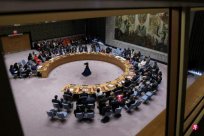
The United Nations Security Council in April this year wrote down the turning point in the Space War era.A proposal carrying a peaceful vision calls for aerospace power to jointly ban large weapons in outer space. The main space of the main space should be kept and used for all human beings.Unfortunately, this proposal proposed by the United States and Japan finally failed to approve (Russia) and 1 vote abandonment (China) in favor of 13 votes, 1 voting, and 1 voting, marking the cracks of the international community on the issue of space and peace.
The debate between the United States and Russia surrounding the militaryization of space suddenly heated up. The two sides held their own words, and the gunpowder flavor was strong.Washington pointed out that Moscow secretly developed anti -satellite nuclear martial arts, threatening space security; Russia resolutely denied that it reiterated its opposition to foreign space nuclearization.The United Nations stated that it would abide by the outer space treaty, calling on countries to actively promote peaceful use of external spaces and prevent the militaryization of space.
Looking back at the Cold War, the space competition is not only a catalyst for scientific and technological progress, but also a silent battlefield for great powers.Gagarin's Space's first and Ambolot's moon in Ambarin, all of which are marked with the marks of military competition.Even after the disintegration of the Soviet Union, although space has gradually retreated to war, military utilization, such as the military origin of the spy satellite and the global positioning system (GPS), still reveals the deep connection between space and national security.In fact, GPS is also the first to develop in the military field. Both of them need to use GPS technology because of precise weapons and military investigations.
In recent years, with the maturity of rocket launch technology and the expansion of satellite networks, especially the maturity of the SpaceX Rocket recycling technology and the advancement of the star chain plan, the discussions of space militaryization are becoming increasingly fierce.Sino -Russian and other countries are concerned that star chain satellites may become the "eyes" of the US military and peek into the secrets of other countries. Therefore, the response is strong, and it may even promote Russia to accelerate the development of anti -satellite weapons.At the same time, the US X-37B space aircraft project, with mysterious tasks and long-term rail capacity, triggers the various speculations of its military use and exacerbated the suspicion of space militaryization.
The outside world has paid great attention to the military intention of the United States in the space field for a long time. Among them, the X-37B unmanned military space aircraft project is particularly noticeable.Since 2010, the United States has continued to carry out the X-37B flight test. Six space aircraft have completed six tasks. The most recent feat is to continue to fly on the track for 908 days, and then returned to voyage.Although the US official emphasizes the mission of X-37B to explore advanced space technology and has ultra-high-speed flight capabilities, the confidentiality and vague description of task details stimulates a wide range of guessing the United States in secret testing space weapons.
The senior personnel of the Russian state-owned defense giant Almaz-Antey also publicly claimed that the United States holds rail bomber with nuclear weapons capabilities, implying that X-37B is such a potential platform.In view of the rapid maneuverability of X-37B, it can easily avoid the radar monitoring system of most countries, which undoubtedly exacerbates its concerns as a potential space weapon system, further blurring the boundaries between peace exploration and military preparation.
In 2020, the establishment of the United States Space Army heralded that more countries may enter this ranks one after another, so that the peaceful wipes of space in space can be shadow.In the conflict between Russia and Ukraine, the application of satellite communication and drone operations further highlights the indispensable and potential risks of space resources in modern warfare, and prompt the international community to face the far -reaching impact of the militaryization of space.In this context, space is no longer a pure field of scientific research and exploration, and it has become one of the core considerations of the national security strategy.




